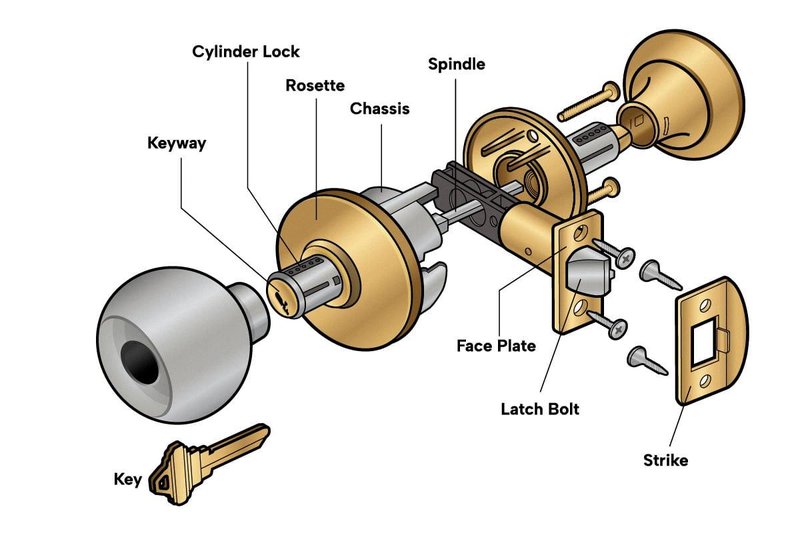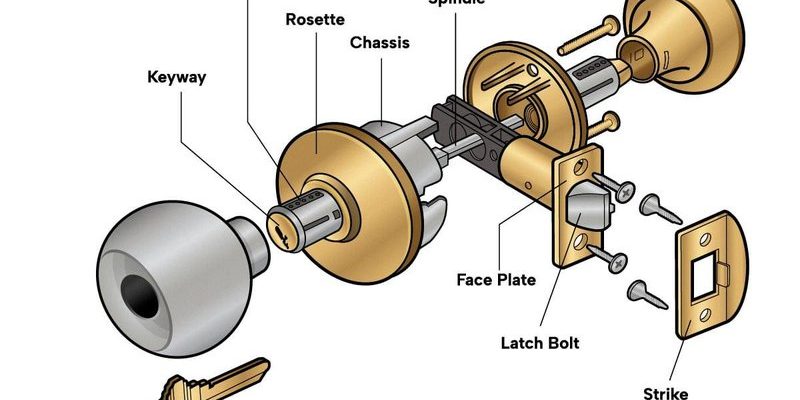
So, what makes up a standard interior door knob? Think of it as a well-tuned orchestra where each instrument—each component—has a specific role in creating harmony. In this article, we’ll break down the parts of a typical door knob, exploring how they work together to perform their tasks. Whether you’re considering a replacement or just curious about how things work, this guide will give you a clear understanding.
The Main Parts of a Door Knob
When you look at a door knob, you might see just a shiny piece of hardware. However, there’s a lot more going on beneath the surface. A standard interior door knob consists of several key components:
- Knob or Lever: This is the part you grab to open the door. It can be round (knob) or flat (lever) and comes in various styles.
- Spindle: A metal rod that connects the two knobs. It’s what allows one knob to turn the other.
- Striker Plate: This metal plate is mounted on the door frame to align with the latch and help keep the door closed.
- Latch Mechanism: This is the internal component that secures the door when closed. When you turn the knob, it retracts, allowing the door to open.
- Housing: The casing that holds everything together and fits into the door.
Each of these parts has its own role, and together they make up the complete door knob assembly. You might be wondering why these details matter—understanding them can help you troubleshoot common issues down the line or even replace the knob yourself if needed.
How a Door Knob Works
Let’s dive a bit deeper into how these components work together. When you turn the knob, the spindle rotates. This rotation connects to the latch mechanism, pulling it back and allowing the door to swing open. Think of it like pulling the string on a puppet. When you pull the string (turn the knob), the puppet (the latch) moves, setting everything in motion.
Here’s the thing: when the door is closed, the latch snugs into the striker plate, keeping your space secure. If it doesn’t fit correctly, you could have trouble closing the door or even keeping it closed. This is why some door knobs come with adjustable latches. They can be moved in and out to fit various door thicknesses, giving you a custom fit.
If you’ve ever struggled with a stubborn door knob, it’s usually due to wear and tear on one of these components. Rust, dust, or even a loose screw can cause the knob to stick or make it difficult to open. Understanding these parts gives you insight into how to fix these issues or even choose a better knob.
Types of Door Knobs
There are several types of interior door knobs, and the right one for you can depend on the door’s purpose. Here are a few common types:
- Passage Knobs: These knobs allow free passage without locking—perfect for hallways or closets.
- Privacy Knobs: Ideal for bedrooms and bathrooms, these can be locked from the inside but not from the outside.
- Dummy Knobs: These aren’t functional knobs. They’re just for decoration or to pull a door closed.
- Keyed Entry Knobs: These offer a lock and key feature and are typically used for entryways or exterior doors.
Choosing the right type for your needs will ensure that your doors function properly and fit the overall aesthetic of your home. Each knob serves a unique purpose, and knowing the differences can help you avoid making a purchase you won’t be happy with.
Common Issues with Door Knobs
Even the best door knob can run into some issues over time. Here are a few common problems you might encounter and how to tackle them:
- Sticking or Stuck Knob: This is often due to dirt or old lubricant. Try cleaning the knob and applying fresh lubricant to the mechanism.
- Loose Knob: If your knob wobbles, check the screws connecting it to the door. They may need tightening.
- Key Issues: For keyed knobs, if your key isn’t turning smoothly, there might be debris in the lock—cleaning it can usually help.
Sometimes a simple fix can save you a lot of hassle. If these problems persist, it might be time to consider a full replacement.
Replacing a Door Knob
If you’re thinking of replacing your door knob, don’t worry—it’s a manageable DIY project. Here’s a basic process to follow:
1. Remove the old knob: Start by unscrewing the screws on the knob’s plates and pulling the two knobs apart.
2. Take out the spindle and latch: Once the knobs are off, remove the spindle and the latch mechanism from the door.
3. Install the new hardware: Place the new latch and spindle into the door, then attach the two knobs securely.
4. Test the function: Before declaring victory, make sure to test the knob to ensure everything works smoothly.
That’s it! You’ve just successfully replaced a door knob. You might be wondering about your new knob’s style or finish. Take your time choosing something that fits both the look of your home and your personal taste.
Understanding the components of a standard interior door knob opens up a whole new world of appreciation for this everyday item. From the knobs you turn daily to the latches that keep your spaces secure, every part plays its role in the comfort and security of your home. So the next time you turn that knob, remember—it’s not just a door accessory; it’s a well-engineered piece of hardware that keeps your home safe.
With a little care and understanding, you can keep your door knobs functioning properly for years to come. Whether you’re maintaining your current knobs or contemplating an upgrade, you’re now equipped with the knowledge to make informed decisions.
